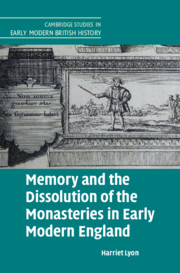Book contents
- Memory and the Dissolution of the Monasteries in Early Modern England
- Cambridge Studies in Early Modern British History
- Memory and the Dissolution of the Monasteries in Early Modern England
- Copyright page
- Dedication
- Contents
- Figures
- Acknowledgements
- Note on the Text
- Abbreviations
- Introduction
- Chapter 1 ‘No News but the Abbeys Shall Be Down’
- Chapter 2 ‘Worthy of Lasting Memory’
- Chapter 3 ‘Raised Out of the Ruins’
- Chapter 4 ‘Many Pretty Odd Tales’
- Conclusion
- Bibliography
- Index
Conclusion
Published online by Cambridge University Press: 08 October 2021
- Memory and the Dissolution of the Monasteries in Early Modern England
- Cambridge Studies in Early Modern British History
- Memory and the Dissolution of the Monasteries in Early Modern England
- Copyright page
- Dedication
- Contents
- Figures
- Acknowledgements
- Note on the Text
- Abbreviations
- Introduction
- Chapter 1 ‘No News but the Abbeys Shall Be Down’
- Chapter 2 ‘Worthy of Lasting Memory’
- Chapter 3 ‘Raised Out of the Ruins’
- Chapter 4 ‘Many Pretty Odd Tales’
- Conclusion
- Bibliography
- Index
Summary
The dissolution of the monasteries proved difficult to forget. Long after the last religious houses fell in 1540, contemporaries continued to grapple with its consequences for religion, property, and everyday life in local communities. This was an episode that shaped early modern historical consciousness and perceptions of the landscape, and which loomed large in contemporary understandings of – and anxieties about – the origins of the English Reformation. The story of the dissolution, as we have seen, could be told in many ways, including as part of a national history or in any number of local variants. The Henrician vision of the reform and surrender of the monasteries was only one possible narrative. Successive generations perpetuated, refined, and contested aspects of this view. In doing so, they revealed the true extent of the seismic transformation wrought by the dissolution in the 1530s. In the foregoing chapters, we have also seen how the domains in which contemporaries remembered the dissolution were as varied and diverse as those memories themselves: polemic, histories, chronicles, topographies, popular print, depositions, poetry, sacrilege narratives, local traditions, and the residues of oral culture have all informed our understanding of the significance of the dissolution in early modern England.
- Type
- Chapter
- Information
- Publisher: Cambridge University PressPrint publication year: 2021



